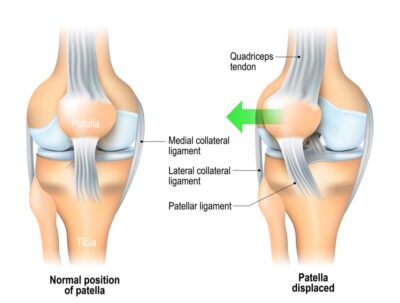Patella Dislocation and Instability Specialist

Do you participate in a sport that causes quick changes in direction while the foot is planted such as lacrosse, tennis, football or basketball? If so, you are at risk for experiencing a patellar dislocation. Recurrent patellar dislocations can lead to patellar instability which can make the knee feel like it will “give way” and not support your weight. Patellar dislocation and instability specialist Doctor Riley J. Williams provides diagnosis as well as surgical and nonsurgical treatment options for patients in Manhattan, Brooklyn, New York City and surrounding areas who are experiencing symptoms of a patellar instability caused from reoccurring patellar dislocations. Contact Dr. Williams’ team today!
What is a Patellar Dislocation?
The knee joint is formed by three bones: the femur (thighbone), tibia (shinbone) and the patella (kneecap). The bones of the knee joint are held in place by a group of ligaments and tendons. As the knee joint moves, the patella glides up and down in the front of the knee on a groove in the femur called the trochlear groove. A patellar dislocation occurs when the patella bone comes out of position on the trochlea. The patella typically moves or jumps outside of the trochlear groove in the lateral (outside) position. A kneecap dislocation usually occurs as a result of damage to the medial patellofemoral ligament (MPFL). Medial patellar dislocations can also occur but are rare. Dr. Riley J. Williams, orthopedic knee specialist, treats athletes and patients in Manhattan, Brooklyn, New York City, NY and surrounding areas who have experienced a patellar dislocation.
What is patellar instability?
Patellar instability describes the condition where the kneecap moves abnormally relative to the trochlear groove; this often happens as the result of a patellar dislocation. When the patella moves outside of the groove on the femur, the supporting structures can be stretched or torn, allowing the patella to move further than it should. There are two types of patellar instability:
- Traumatic Patellar Dislocation – This is the result of an acute injury to the knee when the patella is pushed completely out of the trochlear groove.
- Chronic Patellar Instability – This occurs when the patella slides partially out of the groove in the absence of trauma. This is also called patellar subluxation.
How does a patellar dislocation occur?
Kneecap or patellar dislocations are most often the result of a traumatic event such as a fall, auto accident, or sports injury. Dr. Williams sees this common injury in athletes when they change direction suddenly with a foot planted on the floor. This injury can occur during soccer, basketball, dance, football, lacrosse or tennis. A direct blow to the knee can also cause a patellar dislocation.
What are the symptoms of a patellar dislocation?
Common symptoms include:
- Extreme Pain
- Knee deformity at the time of dislocation
- Popping or cracking sound in the knee
- Continued pain along the inside of the kneecap
- Bruising
- Swelling
- Hemarthrosis – or a collection of blood in the joint
- Locking or catching in the knee joint
- Feeling of instability – knee giving way
How is a kneecap dislocation injury diagnosed?
Dr. Williams will request a patient history and will conduct a through examination of the knee. He may order x-rays to check for fractures or other bone damage. He will often require an MRI scan to see if there is tissue damage to the ligaments, tendons, or cartilage. Not all patellar dislocations require an MRI and Dr. Williams will determine, based on the severity of the patient’s symptoms if an MRI is required. If the patient is experiencing patellar instability or recurrent patellar dislocations an MRI or CT scan can help determine the cause.
What is the treatment for a patellar dislocation?
The first step after a patellar dislocation is to relocate the kneecap into the trochlear groove. This often occurs spontaneously as the athlete extends the knee, or while still participating in a sporting activity. If the patella does not immediately move back into the trochlear groove, an orthopedic specialist will need to move it back into place (often done on the field or in an emergency room).
Patellar dislocations can cause patellar instability; therefore, any type of patellar dislocation should be addressed with Dr. Williams for proper treatment.
Non-surgical treatment after the patella has been relocated may include:
- Rest, ice, compression, elevation
- Pain relievers, NSAID’s such as ibuprofen
- Hot and cold therapy
- Bracing
- Physical Therapy
What is the treatment for patellar instability?
Patellar instability caused by torn or damaged ligaments requires surgery because the connective tissue does not have the ability to heal on its own. Surgical treatment is centered upon restoring functional ligaments to stabilize the kneecap and realignment procedures to correct abnormal patellar tracking due to bony deformity. Dr. Williams is extremely skilled at treating patellar instability and may use one or more of the following surgical treatments to restore the stability of the patella:
- Knee Arthroscopy – Allows Dr. Williams to see the damage inside the knee and make repairs when possible.
- Medial Patellofemoral Ligament (MPFL) Reconstruction
- Tibial Tuberosity Transfer or Osteotomy
For more information on a patellar dislocation or on patellar or kneecap instability and the treatment options available, please contact the office of Riley Williams, MD, orthopedic knee specialist serving Manhattan, Brooklyn, New York City, NY and surrounding areas.
Locations
610 W 58th Street
New York, NY 10019
148 39th Street, 7th Floor
Brooklyn, NY 11232




